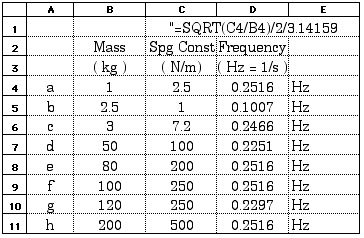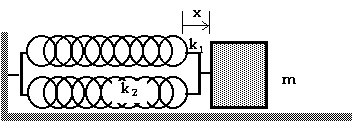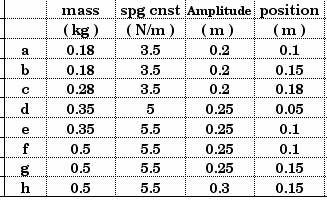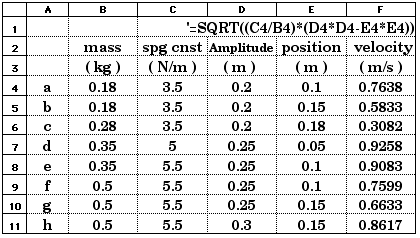
PHY
1150
Chapter 13; Oscillations
about Equilibrium
![]()

PHY
1150
Chapter 13; Oscillations
about Equilibrium
![]()
| Return to Calendar |
D13.1 Find the frequency of a mass on a spring oscillator with the following values for the mass and the spring constant:
mass (kg) |
spring constant ( N / m ) |
|
a |
1.0 |
2.5 |
b |
2.5 |
1.0 |
c |
3.0 |
7.2 |
d |
50 |
100 |
e |
80 |
200 |
f |
100 |
250 |
g |
120 |
250 |
h |
200 |
500 |
This is an excellent one to solve with a spreadsheet:

D13.2 Find the frequency of the oscillator in this arrangement with the mass attached between two springs of spring constants k 1 and k 2.

The next arrangement of springs is a
little more "tricky" or more interesting. Find the frequency of the oscillator
in this arrangement with the mass attached to two springs of spring constants
k 1
and k 2
as shown in the diagram here.

And with this third arrangement, again, find the frequency of the oscillator with the mass attached to two springs of spring constants k 1 and k 2 as shown in the diagram here.

For any simple harmonic oscillator, we have
![]()
where k in this equation is the "effective
spring constant", the spring constant of a single spring that has
the same effect as the combination of springs in the diagram.

With this arrangement, a displacement of x causes a force of F1 = - k 1 x due to the spring on the left and a force of F2 = - k 2 x due to the spring on the right.
The net force, then, is Fnet = F1 + F2 = - k 1 x - k 2 x = - (k 1 + k 2)x. Since the effective spring constant, keff is the constant is Fnet = - k eff x, we can see that
k eff = k 1 + k 2 The next arrangement of springs is a little more "tricky" or more interesting:

When the mass is moved a distance x, spring #1 stretches a distance x 1 and spring #2 stretches a distance x 2 with
x = x 1 + x 2 That is, the two springs need not be stretched (or compressed) the same amount at all. However, the force exerted by each spring must be the same. That is,
F1 = F2 or
k 1 x 1 = k 2 x 2 or
x1 = ( k 2 / k 1 ) x 2 or
x 2 = ( k 1 / k 2 ) x 1
To determine the "effective spring constant", we must write the force in the form of
F = - k eff x We have
F = - k 1 x 1 and
x = x 1 + x 2
x = x 1 + ( k 1 / k 2 ) x 1
x = [ 1 + ( k 1 / k 2 )] x 1

Therefore,

Therefore,

which can also be written as

The third arrangement of springs is actually fairly easy and straightforward. With this arrangement, a displacement of x causes a force of F1 = - k1x due to spring #1 and a force of F2 = - k2x due to spring #2. The stretch of each spring is the same as the displacement of the mass.

The net force, then, is Fnet = F1 + F2 = - k 1 x - k 2 x = - ( k 1 + k 2 ) x. Since the effective spring constant, k eff is the constant is Fnet = - k eff x , we can see that
k eff = k 1 + k 2
D13.3 How much work is done when a spring with spring constant 80 N/m is stretched 0.15 m (or 15 cm)?W = (1/2) k x2
W = (1/2) (80 N/m) (0.15 m)2
W = 0.9 J
D13.4 Consider, as a simple harmonic oscillator, a 200 g (0.20 kg) mass attached
to spring with a spring constant of 50 N/m. If the oscillator has an amplitude
of 10 cm (0.1 m), what is the maximum speed of the mass?
As the mass moves through equilibrium,
x = 0
so it has zero potential energy and its total energy is now all KE,
KE = (1/2) m v 2 = (1/2) (0.2 kg) v 2 = 0.25 J = E
v2 = 2.5 m 2 / s 2
v = 1.58 m / s
D13.5 An object undergoes simple harmonic motion with an amplitude of 12 cm. At a point 8.0 cm from equilibrium, its speed is 20 cm/s. What is the period?
Caution: be very careful with the units!
We have used lower case m for both mass and meters. That gets confusing here so I will go to upper case M for mass.
E = PE max = (1/2) k A2 A = 12 cm = 0.12 m
E = (1/2) ( k ) (0.12 m)2
E = KE + PE = (1/2) M v2 + (1/2) k x2
E = (1/2) M (0.2 m/s)2 + (1/2) k (0.08 m)2 = (1/2) ( k ) (0.12 m)2 = E
M (0.2 m/s)2 = k (0.12 m)2 - k (0.08 m)2
(M/k)(0.2 m/s)2 = (0.12 m)2 - (0.08 m)2
(M/k)(0.04) (m/s)2 = (0.0144 - 0.0064) m2 = 0.0080 m2
(M/k) = 0.2 ( s2 )
T = 2SQRT(M/k)
T = 2.8 sec
D13.6 For each of the simple harmonic oscillators listed in the table below, find the velocity of the mass at the position given:

These multiple-data-set problems are good ones to solve with a spreadsheet. This is basically energy conservation,
E = (1/2) k A2 = (1/2) k x2 + (1/2) m v2
k A2 = k x2 + m v2
m v2 = k (A2 - x2)
v2 = (m/k) (A2 - x2)

So this will be the formula we put in the spreadsheet:

D13.7 A 50-g (0.050 kg) mass hanging from a spring oscillates with a frequency
of 2 Hz. What is the spring constant?
f 2 = ( 1/2 ![]() )
2 (k/m)
)
2 (k/m)
f 2 = ( 1/4 ![]() 2)(k/m)
2)(k/m)
k = 4 ![]() 2
f 2 m
2
f 2 m
k = 4 ![]() 2
[2 (1/s )] 2
(0.050 kg)
2
[2 (1/s )] 2
(0.050 kg)
k = 3.95 kg/s2
k = 3.95 N/m
![]()
| Return to Calendar |
(c) 2005, Doug Davis; all rights reserved